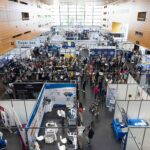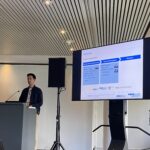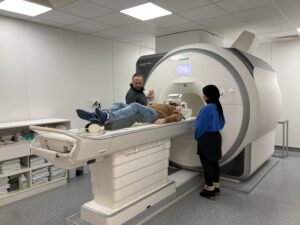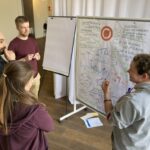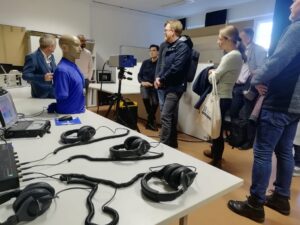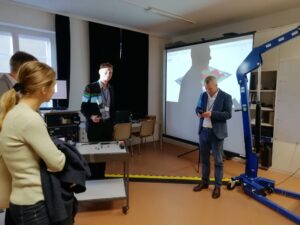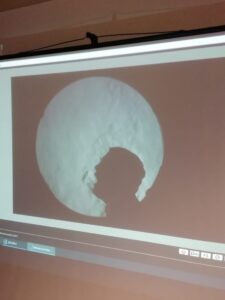Kategorie: ‘Events’
IEA HPT Annex 63 Meeting in Aachen
On October 23rd to 24th, 2024, the participants of the IEA HPT Annex 63 project met in Aachen for their first in-person meeting, hosted by RWTH Aachen University and HEAD Acoustics GmbH. Annex 63 is part of the International Energy Agency’s Heat Pumping Technologies initiative, focusing on the Placement Impact on Heat Pump Acoustics. The Annex 63 includes groups for five task areas: Building Acoustics Impact of Heat Pumps, Urban Acoustics Impact of Heat Pumps, Psychoacoustics of Heat Pumps, Digitally Assisted Heat Pump Placement, and Dissemination. During this fourth working meeting, all task groups presented their current status and opened up for discussions.
Our Institute is mainly involved in the third workgroup (Psychoacoustics of Heat Pumps), where the contents are closely linked to our research project LowNoise, in which the acoustic emissions of air-to-water heat pumps are investigated.
Besides the lively exchanges, the project members also got the chance to see the laboratory at HEAD Acoustics GmbH, as well as at the Institute for Energy Efficient Buildings and Indoor Climate and the Institute for Hearing Technology and Acoustics of the RWTH Aachen University. Thanks to everyone involved for their contributions, and a special thanks to Christoph Reichl from the Austrian Institute of Technology for organizing this interesting initiative, aiming to improve the noise impact of environment-friendly technologies such as heat pumps.
- Photo: Jonas Klingebiel
- Photo: Lukas Aspöck
Inter-Noise 2024 in Nantes
This year’s Inter-noise conference took place from August 25th to 29th in Nantes, France. More than 1500 delegates participated in this conference and presented interesting research in the field of acoustics and noise. Highlights of the conference included a plenary talk by Arnaud Can and Pierre Aumond (Joint Research Unit in Environmental Acoustics at Gustave Eiffel University, Nantes, France) on advanced characterization of urban sound environments and a keynote lecture about the child perspective on noise exposure and health effects, held by Kerstin Persson Waye from Gothenburg University, Sweden, who is also collaborating with IHTA in the Equal-Life project.
Members of IHTA travelled to the conference and presented the following research papers:
- Chalotorn Möhlmann: Validation measurement of vehicle pass-by models for dynamic urban environments (results of the BaLSaM project)
- Marco Berzborn: Inference of the acoustic properties of transversely isotropic porous materials
- Lara Stürenburg: Loudness and preference judgments for noises of a heat pump (results of the LowNoise project)
- Joao Fatela (Guest researcher from the University of Campania Luigi Vanvitelli, Naples, Italy):
An experimental setup to investigate relevant validation parameters for the auralization of commercial aircraft flyovers in complex urban contexts
Directly after the closing ceremony of the conference, the satellite workshop “Unlocking the Potential of Open Research Software in Acoustics at Inter-Noise 2024” started. This event was organized by Maarten Hornikx and Huiqing Wang, from the Building Acoustics team of Eindhoven University of Technology, and included interesting exchanges and presentation on the development, maintenance, documentation and distrubtion of acoustics-related open-source software. As one of four invited speakers, Lukas Aspöck held a presentation about IHTA’s auralization software Virtual Acoustics. The slides of this presentation are available for download (CC BY-SA 4.0).
Next to insightful overview presentations by Maarten Hornikx and Huiqing Wang, further successful research software was presented: Pyroomacoustics by Eric Bezzam, NoiseModelling by Pierre Aumond and SoundScapy by Andrew Mitchell, along with many examples of challanges and best practices for open research and open-source software development. Many thanks to Maarten and his team for the invitation and the organization of this exciting event.
- Entrance of the InterNoise venue. Photo: Lukas Aspöck
- Exhibition area at Internoise. Photo: Simon Bianchetti.
- Internoise 2024 Macarons. Photo: Lukas Aspöck
- Kerstin Persson Waye at her keynote presentation. Photo: Simon Bianchetti.
- Jam Session @ InterNoise. Photo: Lukas Aspöck
- Lara during her presentation. Photo: Lara Stürenburg.
- Chalotorn during his presentation. Photo: Carolin Schliephake.
- Lukas during the research software workshop. Photo: Enkela Alimadhi
2nd IHTA Retreat
On the 23rd and 24th of May 2024, the scientific staff of IHTA was on a retreat at Fährhaus km734 in Düsseldorf. During these two days, the aim was to foster collaboration and exchange between the researchers. Next to an inspiring presentation on personal strengths and interests by the moderator and career coach Bastian Hughes, we helped each other understand individual challenges in more depth by visiting different world cafés. Further, we learned that most researchers face the same obstacles during their careers. Team spirit was challenged during an evening pub quiz and finding solutions for the identified obstacles in team sessions.
Overall, it was two successful days with a lot of input for each individual and a lot of output for the group at IHTA.
A big thank you to Bastian Hughes, who guided us through the two days with his great moderation!

Vortrag von Bastian Hughes

Ergebnisse der World Cafés
Einladung zum Halbzeittreffen des BaLSaM-Projekts am 21.5.
Das Konsortium des Projekts “Braunkohlereviere als attraktive Lebensräume durch Straßengeräuschsimulation auf Basis bestehender Verkehrsdaten zur Minimierung von Lärm”(BaLSaM) lädt zum öffentlichen Halbzeittreffen ein. Es wird am 21.5.2024 von 8:30-13:00 Uhr im Institut für Kraftfahrzeuge der RWTH Aachen University stattfinden (Adresse: Steinbachstraße 7, 52074 Aachen, Deutschland).
Während des Treffens werden die Projektpartner den bisherigen Fortschritt des Projekts zu präsentieren. Darüber hinaus wird das Event die Gelegenheit bieten, Erfahrungen auszutauschen und gemeinsam an zukünftigen Herausforderungen und Fragestellungen zu arbeiten. Neben der Teilnahme vor Ort ist auch eine digitale Teilnahme an der Veranstaltung möglich. Bitte füllen Sie in beiden Fällen das folgende Formular aus, um sich für die Teilnahme zu registrieren.
Anmeldung: https://www.balsam-projekt.de/de/halbzeitevent.html
Agenda:
| 08:30 | Ankommen |
| 09:00 | Begrüßung |
| 09:10 | Projektvorstellung |
| 09:30 | Beschreibung der Schallquelle Fahrzeug |
| 10:00 | AVAS-Geräuschband & Lärmwahrnehmung |
| 10:30 | Kaffeepause |
| 11:00 | Schallausbreitungssimulation |
| 11:30 | Optimierungsstudie |
| 12:00 | Pause für offenen Austausch |
| 12:30 | Abschluss mit Institutsführung |
— English version —
The consortium of the project “Braunkohlereviere als attraktive Lebensräume durch Straßengeräuschsimulation auf Basis bestehender Verkehrsdaten zur Minimierung von Lärm” (BaLSaM) invites you to the public mid-term meeting. It will take place on May 21, 2024 from 8:30-13:00 at the Institute of Automotive Engineering at RWTH Aachen University (address: Steinbachstraße 7, 52074 Aachen, Germany).
The BaLSaM project investigates how traffic noise can be simulated and auralized, aiming to develop concepts to minimize road noise to create more pleasant environments. During the meeting, the project partners will present the progress of the project. In addition, the event will provide an opportunity to exchange experiences and discuss future challenges and research questions. In addition to on-site participation, digital participation in the event is also possible. In both cases, please fill out the following form to register for participation.
Agenda and registration: https://www.balsam-projekt.de/de/halbzeitevent.html
Promotionsprüfung Thiago Lobato
Am 12.04.2024 hat Herr Thiago Lobato seine Promotionsprüfung zum Thema „Improving sound source localization and characterization with machine learning techniques“ erfolgreich abgeschlossen.
Das IHTA gratuliert herzlich!

Bild: Julian Becker/Roland Sottek
junge DEGA Herbstworkshop 2023 in Aachen
From 17th to 19th November 2023, the “junge DEGA Herbstworkshop” (autumn workshop) took place in Aachen. Junge DEGA is a section of the German Acoustical Society (DEGA) and partner of the Young Acousticians Network (YAN) of the European Acoustics Association (EAA). Its mission is to connect students, PhDs and young professionals in the domain of acoustics. The group organizes special sessions and panel discussions during the Annual German Conference on Acoustics (DAGA), providing information on research opportunities and job entry. Furthermore, junge DEGA offers a mentoring program with active participation from industry and academia.
The workshop started on Friday afternoon with a visit of HEAD Acoustics GmbH in Kohlscheid, where the participants got insights into the company’s research and development activities and experienced some hands-on demonstrations of new products. After this first visit, three RWTH spin-offs – FEV, KLANG, elevear – reported on their experiences in business practice and illustrated different career paths in the field of acoustics. The first day concluded with a meeting of the group resuming the year’s activities and discussing the plans for the upcoming conference DAGA 2024.
On Saturday, the participants visited four laboratories at RWTH Aachen University. The day started with a welcoming tour at the Institute for Hearing Technology and Acoustics (IHTA) with demonstrations of the room acoustics simulation software RAVEN, experiments for audio-visual perception studies and the SCaLAr loudspeaker array. The Institute for Automotive Engineering (ika) opened the doors to their semi-anechoic climate chamber and to a broad range of tire test rigs, which are used to determine the dynamic load during tire-road contact under the influence of different road surfaces. The Experimental Behavioral Psychobiology group & Brain Imaging Facility at RWTH University hospital presented research in which specific acoustic stimuli are used during magnetic resonance imaging to better understand the auditory processing with schizophrenia. Finally, the III. Physics Institute B presented its research on a sonar- and radar-equipped melting probe which aims to penetrate the ice shield and explore the subglacial ocean of the Jovian moon Europa (TRIPLE). Another project focused on the use of acoustic measurements to calibrate the neutrino observatory IceCube.
The weekend concluded with a hands-on workshop on binaural synthesis and virtual acoustics applications (see virtualacoustics.org) at IHTA.
Thanks to all participants and supporters!
- III. Physics Institute B, Photo: Jonas Heck
- Brain Imaging Facility at RWTH University hospital, Photo: Jonas Heck
- Institute for Automotive Engineering (ika), Photo: Olaf Uszynski
- Hands-on workshop at IHTA, Photo: Pascal Palenda
Aachen Acoustics Colloquium 2023
Next week the 14th Aachen Acoustics Colloquium will take place at Parkhotel Quellenhof in Aachen. On Tuesday, November, 28th and Wednesday, November, 29th, the scientific program includes 22 interesting presentations about current research within the area of automotive acoustics, accompanied by a technical exhibition from various companies and research institutes. A detailed overview of the program can be found in this PDF.

Our Institute contributes to two presentation to this conference:
- Mark Müller-Giebeler: “FE-Based Inverse Approach to Determine Complex Acoustic Material Parameters in Alpha Cabins”
- Chalotorn Möhlmann: “Holistic Approach for Aurally Accurate Road Traffic Noise Reduction by Adaption of Traffic Routes and Infrastructure Planning” (together with Carolin Schliephake, part of the BalSaM project)
Registration for the on-site participation this event is no longer available, but the registration for online participation is still possible on the AAC website.
DAGA 2024 Travel Grants
Die Gesellschaft für Technische Akustik (GfTA e.V.) möchte Studierende des IHTAs unterstützen an der kommenden Jahrestagung für Akustik (DAGA 2024) teilzunehmen. Diese findet vom 18. bis zum 21. März 2024 in Hannover statt und bietet eine sehr spannende Möglichkeit, erste Erfahrungen bei wissenschaftlichen Konferenzen zu sammeln.

Die GfTA fördert in diesem Jahr zwei Studierende mit einen Reisezuschuss (Travel grant) in Höhe von jeweils 250€. Kandidat*innen müssen keinen wissenschaftlichen Beitrag bei der Konferenz einreichen, sollten aber zuvor noch keine DAGA-Konferenz besucht haben und an mind. einer Lehrveranstaltung am IHTA teilgenommen oder eine Abschlussarbeit angefertigt haben / aktuell anfertigen.
Um Dich für den Travel grant zu bewerben, schreibe eine Email an Lukas Aspöck und erkläre in ein oder zwei Sätzen, warum Du motiviert bist an einer Akustik-Konferenz teilzunehmen. Die Deadline für Bewerbungen ist der 14.12.2023, die Bekanntgabe findet bei der IHTA-Weihnachtsfeier am 19.12.2023 statt.
junge DEGA Herbstworkshop 2023 – Ankündigung
Die Fachgruppe „junge DEGA“ der Deutschen Gesellschaft für Akustik e.V. (DEGA) veranstaltet regelmäßig einen Herbstworkshop mit dem Ziel, junge Akustikerinnen und Akustiker (Studierende, Promovierende, Young Professionals) zu vernetzen und persönlichen Austausch zu ermöglichen. Der diesjährige Herbstworkshop wird organisiert durch die aktuelle Leitung der Fachgruppe (Simon Kersten und Jonas Heck) mit Unterstützung weiterer Kolleg:innen des IHTA. Der Workshop findet vom 17.-19. November 2023 in Aachen statt.
Auf dem Programm des Herbstworkshops steht:
- Besuch des Instituts für Hörtechnik und Akustik (IHTA) an der RWTH Aachen, inkl. „Hands-On“-Workshop zur virtuellen Akustik
- Austausch zu Fach- & Promotionsthemen der Teilnehmenden
- Besuch weiterer Forschungseinrichtungen an der RWTH & Industriepartner
- Sitzung der junge DEGA-Fachgruppe
Anmeldung und Details zum Programm: https://www.dega-akustik.de/junge-dega/projekte (Anmeldeschluss: 31.10.2023).

Research trip to Santiago de Chile
From October 10th to October 13th 2023, Lukas Aspöck participated in the workshop “Digital transformation in the development of rehabilitation sciences: the current challenge to use state-of-the-art technology” on behalf of the Institute for Hearing Technology and Acoustics.
The workshop was held in Santiago de Chile and Valparaíso and was mainly hosted and organized by the Universidad San Sebastián. The program included many interesting presentations by national and international researchers related to machine learning, virtual reality and the development of sensors and tools which can be applied within different fields of rehabilitation and related research. As part of the workshop, the researchers also visited various facilities, ranging from laboratories and workshops for speech therapy and audiology to a healthcare unit for physical rehabilitation and the research and technology transfer center AC3E of the Federico Santa María Technical University.
- Visit at the AC3E research center, Valparaiso Photo: Sandra Rojas
- The organisation team of the event Photo: Lukas Aspöck
- Lukas during his presentation Photo: Rhoddy Viveros
- Speech lab in AC3E center in Valparaiso Photo: Lukas Aspöck
Lukas contributed to the event by giving a 60-minute presentation with the topic “Virtual reality environments for research in acoustics and audiology”. The slides of this presentation are available here.
Many thanks to our former colleague Rhoddy Viveros for the organization and the invitation to this event. Thanks also to the rest of the organization team, which was led by Carla Contreras and also included Sandra Rojas, Matías Zañartu and Cristhian Mendoza. The event was funded by the Chilean National Research and Development Agency (International Linkage FOVI220126).
Jahrestagung der Gesellschaft für Musikforschung 2023
Im Rahmen der Jahrestagung der Gesellschaft für Musikforschung 2023 in Saarbrücken fand am 5. Oktober 2023 ein Marktplatz aktueller Forschung statt, in der Methoden und Werkzeuge für die digitale Musikforschung präsentiert werden konnten. Im Zuge der Zusammenarbeit mit Prof. Stefan Morent von der Universität im Projekt „Sacred Sound – Sacred Space“ demonstrierten unsere Mitarbeitenden Carolin Breuer und Pascal Palenda die Möglichkeiten, Räume akustische zu simulieren und auralisieren, in virtuelle Räume hinzusingen oder zu musizieren, sowie Räume in der Virtuellen Realität mit Hilfe eines Head-Mounted-Displays interaktiv akustisch-visuell erlebbar zu machen.
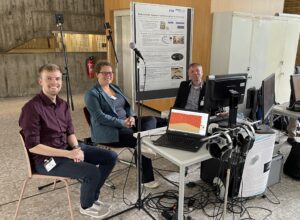
Stand bei der Jahrestagung für Musikforschung. Foto: Martin Albrecht-Hohmaier
60 Jahre I(H)TA- Fest
Am Samstag, den 19. August 2023 wurde das 60-jährige Bestehen des IHTA/ITAs gefeiert.
Das Institut für Technische Akustik wurde nach einer Übergangphase ab 1961 offiziell am 2.1.1964 mit Prof. Dr. Wilhelm Janovsky als erstem Leiter gegründet. Es folgten 1972 Prof. Dr. Heinrich Kuttruff, 1996 Prof. Dr. Michael Vorländer und schließlich seit 2020 Prof. Dr.-Ing. Janina Fels als Leitung des heutigen Instituts für Hörtechnik und Akustik.
Über 120 Ehemalige und Aktive des Instituts nahmen an der Feier mit Führungen und Demonstrationen aktueller Forschungsthemen und natürlich am Essen, Getränken und Live-Musik der IHTA-Band teil.
Ein besonderer Dank gilt hier der Gesellschaft für Technische Akustik e.V. (GfTA), die diese Feier ermöglicht hat. Wer noch nicht Mitglied im Verein ist, kann dies hier (Beitrittserklärung) werden, damit wir auch weiterhin das Netzwerk aus Ehemaligen und Aktiven und dem Nachwuchs in der Akustik unterstützen und pflegen können.








1st IHTA Retreat
An interchange for good teamwork between researchers
On 28th and 29th March 2023, the scientific staff of IHTA was on a retreat at Gut Hohenholz near Bedburg in the Rhein Erft Kreis. During these two days, the institute’s past was reflected, and it was discussed how the future of the IHTA can be shaped together. Moreover, there was an intensive exchange among each other’s scientific work in the form of poster sessions. The researchers presented each other’s projects and revealed which milestones needed to be reached to achieve specific goals. Between poster sessions team spirit was strengthened, and the future of teaching and workflows were addressed. Furthermore, it was discussed how the skills of individual researchers could be maintained and passed on to new staff members.
Overall, it was two successful days with a lot of input for each individual and a lot of output for the group at IHTA.
A big thank you to Joachim Bellut, who guided us through the two days with his great moderation!
- Group photo at the IHTA Retreat (Foto: Joachim Bellut)
- Poster session (Foto: Joachim Bellut)
- Poster session (Foto: Joachim Bellut)
- Team building task (Foto: Joachim Bellut)
DAGA 2023 – 49. Jahrestagung für Akustik
Again, IHTA is joining DAGA in Hamburg with interesting contributions from March, 6th, to March, 8th, 2023. We are delighted to invite to our presentations and posters. In total, IHTA members will be represented with 27 contributions (22 presentations and 5 posters):
| Presentations | ||||
|---|---|---|---|---|
| Tuesday, March 7th | ||||
| Jonas Heck, Josep Llorca-Bofí, Aakriti Jain, Michael Vorländer |
Text mining of audio-visual descriptors for concert halls | Raumakustik 1 – Qualitätsfragen und Fallstudien A | 14:00 | Saal X 1-2 |
| Lukas Vollmer, Elisabeta Balla, Björn Kampa, Janina Fels | The Auditory Mismatch Negativity as an EEG-derived Measure of Predictive Coding | Psychoakustik | 14:20 | Saal X 7-8 |
| Lukas Aspöck, Michael Vorländer, Anne Heimes, Andreas Herweg, Olivier Dazel |
An online course about acoustic simulations and auralization | Lehre der Akustik | 15:00 | Saal Y 4 |
| Shaimaa Doma, Cosima Ermert, Janina Fels |
On the monaural contribution to HRTF discrimination | Perceptual Optimization of Dynamic Binaural Rendering 2 | 16:40 | Saal Y 9 |
| Lara Stürenburg, Hark Braren, Lukas Aspöck, Janina Fels | Akustische Vermessung einer Wärmepumpe für Hörexperimente und Simulationen | Strömungsakustik in der Energiewende | 17:20 | Saal X 9-10 |
| Wednesday, March 8th | ||||
| Marco Berzborn, Michael Vorländer | Analytic Model Based Analysis of Modal Sound Field Decay | Raumakustik 2 – Messung und Simulation A | 09:00 | Saal X 1-2 |
| Thomas Deutsch, Janina Fels | Evaluating Models for the Simulation of Cochlear Hearing Loss | Audiologische Akustik 3 – Charakterisierung des Hörsystems | 10:00 | Saal Y 5 |
| Pascal Palenda, Michael Kohnen, Michael Vorländer |
Influence of Position Mismatch on the Perception of Early Reflections of One’s Own Voice | Virtuelle Akustik 1 | 10:40 | Saal X 11-12 |
| Karin Loh, Edina Fintor, Sophie Nolden, Janina Fels | Comparing Children’s and Adults’ Intentional Switching of Auditory Selective Attention in Spatial and Noisy Acoustic Environments | Psychoakustik | 14:00 | Saal X 7-8 |
| Julia Seitz, Karin Loh, Sophie Nolden, Janina Fels | Investigating Intentional Switching of Spatial Auditory Selective Attention in an Experiment with Preschool Children | Psychoakustik | 14:20 | Saal X 7-8 |
| Hark Braren, Janina Fels | Individualized Head-related Transfer Functions for Children | Virtuelle Akustik 3 | 16:40 | Saal X 11-12 |
| Mark Müller-Giebeler, Michael Vorländer | Präzise Modellierung diffuser Schallfelder zur inversen Bestimmung akustischer Materialparameter | Raumakustik 2 – Messung und Simulation B | 17:40 | Saal X 1-2 |
| Anne Heimes, Michael Vorländer |
Measurement setup design for scattering patterns based on numerical simulations | Raumakustik 2 – Messung und Simulation B | 18:20 | Saal X 1-2 |
| Ingo Witew, Michael Vorländer | Wie genau müssen Messpositionen für reproduzierbare Klarheitsmaß Messungen definiert werden? | Raumakustik 2 – Messung und Simulation B | Saal X 1-2 | |
| Thursday, March 9th | ||||
| Chinthusa Mohanathasan, Jonathan Ehret, Cosima A. Ermert, Janina Fels, Torsten W. Kuhle, Sabine J. Schlittmeiers |
Towards More Realistic Listening Research in Virtual Environments: The Effect of Spatial Position of Two Talkers in Conversations on Memory and Listening Effort | SPP2236 – Auditory Cognition in Interactive Virtual Environments 1 | 09:20 | Saal Y 5 |
| Josep Llorca-Bofí, Jonas Heck, Michael Vorländer |
Reproducibility Exploration of Individual Vocabulary Profiles on Urban Soundscapes: Driescher Hof, Aachen | Soundscape | 09:40 | Saal X 5-6 |
| Cosima A. Ermert, Jonathan Ehret, Torsten W. Kuhlen, Chinthusa Mohanathasan, Sabine J. Schlittmeier, Janina Fels |
Audio-visual content mismatches in the serial recall paradigm | SPP2236 – Auditory Cognition in Interactive Virtual Environments 1 | 09:50 | Saal Y 5 |
| Chalotorn Möhlmann, Simon Kersten, Michael Vorländer |
Finite Element Simulation of the Occlusion Effect in the Ear Canal | Assisted Hearing – Testing, Models, Quality 1 | 10:00 | Saal X 11-12 |
| Lukas Aspöck, Stefan Morent, Michael Vorländer | Simulated reverberation for choir recordings in virtual churches | Raumakustik | 10:20 | Plenarsaal |
| Simon Kersten, Henning Taschke, Michael Vorländer | Fluid Motion and Pressure Distribution in the Human Inner Ear during Bone Conduction Hearing | Assisted Hearing – Testing, Models, Quality 1 | 10:20 | Saal X 11-12 |
| Carolin Breuer, Stephan Fremerey, Larissa Leist, Maria Klatte, Alexander Raake, Janina Fels |
Investigating the Influence of Visual Distractors on the Voluntary Switchtig of Auditory Selective Attention in Virtual Reality | SPP2236 – Auditory Cognition in Interactive Virtual Environments 1 | 10:40 | Saal Y 5 |
| Elie Abi Raad, Jose Maria Gomez Belmonte, Michael Vorländer |
Frequency response characterization of the welding process in Ultrasonic Metal Welding | Structure-borne sound | 16:00 | Saa Y6 |
| Poster | ||||
| Wednesday, March 8th | ||||
| Stefan Winkelmann, Lara Stürenburg, Isabel S. Schiller, Janina Fels, Sabine J. Schlittmeier |
Subjektiver akustischer Komfort von Luftdurchlässen für Gebäudelüftungen | Psychoakustik | 15:40-16:20 |
Foyer Z, Posterinsel H |
|
Marco Wegener, Jonas Heck, Josep Llorca-Bofí, Rouben Rehman, Christian Dreier, Philipp Schäfer, Michael Vorländer |
Introducing an Unreal Engine toolkit for audio-visual perception studies in the virtual lab IHTApark | Virtuelle Akustik (Late Poster) |
15:40-16:20 |
Foyer Z, Posterinsel Q |
| Thursday, March 9th | ||||
| Frederike Rust, Karin Loh, Lukas Aspöck, Janina Fels | Auswirkung akustischer Maßnahmen auf das Lärmempfinden im Klassenraum | Raumakustik (Late Poster) |
11:00-11:40 | Foyer Z, Posterinsel R |
| Jianliang Gao, Ingo Witew, Lukas Aspöck, Michael Vorländer, S. K. Tang | Global sound field estimation of a theatre using an efficient multi-channel room acoustic measurement system | Raumakustik (Late Poster) |
11:00-11:40 |
Foyer Z, Posterinsel R |
| Lili Pan, Jianliang Gao, Yuezhe Zhao | An optimized procedure for random-incidence scattering coefficient measurement in 1:10 scaled reverberation room | Raumakustik (Late Poster) |
11:00-11:40 |
Foyer Z, Posterinsel R |
An overview of all contributions and updated information can be found in the DAGA 2023 App.
We are looking forward to seeing you at DAGA 2023!
IHTA at the BauSIM conference in Weimar
From the 20th to the 22nd September 2022, the BauSIM conference took place. The scientific core topic of the conference is traditionally the energetic simulation in the building sector and offers an ideal discussion forum for experts from science and industry for mutual exchange. The conference is organized by the and IBSPA Germany-Austria, member of the International Building and Performance Simulation Association (IBPSA) This year’s conference introduced a new session on acoustic simulation topics, and our institute was present.
In particular, our Junior Principal Investigator Dr. Josep Llorca-Bofí, from the PAAD group was invited as key-note speaker, talking about The city – A machine for noise? Virtual acoustics in architectural design research. Together with our PhD student M. Sc. Jonas Heck and Professor Michael Vorländer, the following research paper was presented: 3D photogrammetry for auralization – An approach for geometry simplification and material categorization.
- Key-note talk Dr. Josep Llorca-Bofí
- Bauhaus-Universtät Weimar
- BauSIM lecture hall
- IHTApark demonstrator
- Immersive audio and visuals
- Portable research laboratory using head-mounted display and equalized headphones
- Visit to the acoustic laboratory at the chair of Building Physics
- Visit to the acoustic laboratory at the chair of Building Physics
- Optic visualization of thermal air movement
- Visit to the optics laboratory at the chair of Building Physics
junge DEGA Workshop 2022 in Stuttgart
From 2nd to 4th September 2022, after a three-years break due to the Covid-19 pandemic, the “junge DEGA Herbstworkshop” took place in Stuttgart, like the DAGA conference earlier this year. Junge DEGA is a sub-group of the German Acoustical Society with the mission to connect students, PhDs and young professionals in the domain of acoustics. It organizes special sessions and panel discussions during the Annual German Conference on Acoustics (DAGA), providing information on research funding opportunities and job entry. Furthermore, junge DEGA offers a mentoring program with active participation from industry and academia.
Two PhD students of the Institute for Hearing Technology and Acoustics, Simon Kersten and Jonas Heck, as well as Nils Rummler, recently graduated bachelor student, participated in this year’s workshop. The program started with visits at the Fraunhofer Institute for Building Physics IBP and the Center for Building Physics (ZfB, Hochschule für Technik Stuttgart). Furthermore, it consisted of short presentations given by the participants, a plenary meeting of the junge DEGA group to plan the following year’s activities and a guided visit of the new main station construction site (known as Stuttgart 21) with a focus on noise and vibration control. The weekend was concluded with a hands-on workshop on building a loudspeaker from residual materials and competing for the highest sound pressure level.
Pictures from the workshop can be found in the gallery below.
- Participants of the junge DEGA Herbstworkshop 2022
- Loudspeaker competition
- Loudspeaker competition
- Loudspeaker competition
- Visit of the Stuttgart21 construction site
Promotionsprüfung Muhammad Imran, M.Sc.
Am 4. Februar 2022 hat Herr Muhammad Imran seine mündliche Promotionsprüfung erfolgreich abgeschlossen.
Herr Muhammad Imran promovierte über das Thema:
„Virtual Building Acoustics – Auralization with contextual and Interactive Features“
Abstract:
Building acoustics auralization is used to assess the perceptual aspects of sound transmission in built environments to provide the guidelines for architectural constructions and to evaluate the noise effects on humans. These noise effects have a negative influence on daily-life activities and create disturbances in physical and metal work. These disturbances are present within the dwellings and/or might be from outdoor moving transient sound sources. Methods are available for auralization of sound insulation between connected rooms in compliance with the standardized data formats of sound insulation metrics and building structural geometries. However, there still exist certain challenges to be addressed to construct the transfer functions between noise sources and receiver room for indoor situations as well as for the outdoor moving sound sources and to make these sources audible through audio-visual virtual reality systems in real time and interactively. These challenges are due to certain simplifications which are implicit in the formulation on which the sound insulation prediction models are based, such as, diffuse field assumptions, neglecting source characteristics, and source and receiver room acoustics.
This thesis focuses on addressing the present challenges in the traditional sound insulation rendering techniques and establishing an interface between psychoacoustic research and building acoustics in dwellings (especially airborne sound insulation) integrated with audio-visual virtual reality environments. From the technical perspective, improvements are made in sound insulation prediction methods, and corresponding filter construction and rendering techniques for auralization. In the first place, the building elements are considered as multitude of secondary sources rather than taking them as point source radiators and the bending wave patterns are addressed in order to be able to properly construct the transfer functions from source to the receiver room. Secondly, the room acoustical simulations are carried out for both source and receiving rooms to generate transfer functions from source to the source room walls and from radiating receiving room walls to the listener, so that the geometries and absorption might be fit to the properties desired by the user for the spatial impression of the listening rooms. In addition, the transfer functions from radiating walls of the receiving room to listener are designed in such a way that not only indoor sources are handled nevertheless the outdoor moving sources are also addressed.
Some important conditions are associated with virtual building acoustics auralization research platform for advanced studies of noise effects in dwellings which are addressed. The audio files, generally, used in listening tests are arbitrarily manipulated by audio samples without the background of a physical model of the built environments. They must comply with the standardized data formats of sound reduction indices (level differences) and/or sound transmission coefficients. Other data related to building structure such as geometry shall be strictly connected to the architectural design, the building materials and constructions. Otherwise the conclusions of the psychoacoustic experiments have no direct correlation with the architectural design, especially when presented through virtual environments. To achieve this, the auralization framework is extended toward real-time interactive audio-visual technology, i.e. VR technology, in order to be able to introduce more realism and, hence, contextual features into psychoacoustic experiments. The building acoustics framework is validated by taking indoor and outdoor example case studies. Listening experiments close to real-life situations are carried out by using this framework to show that this framework can be used as an alternate to design new test paradigms which help to better analyse and interpret the noise impact in building situations depending on the actual activity such as working, learning, and rest.
Das IHTA gratuliert sehr herzlich!!

Doctoral exam Muhammad Imran, Examination committee: Prof. Dr. Kay Hameyer, Prof. Dr. Michael Vorländer, Prof. Dr. Edwin Reynders, Prof. Dr. Peter Jax
Promotionsprüfung Dipl.-Ing. Ingo Witew
Am 21. Januar 2022 hat Herr Ingo Witew seine mündliche Promotionsprüfung erfolgreich abgeschlossen.
Herr Witew promovierte über das Thema:
„Measurements in room acoustics – Uncertainties and influence of the measurement position“
Abstract:
Regardless of the field, measurements are essential for the validation of theories and for making well-founded decisions. A criterion for the validity and comparability of measured values is their uncertainty. The „Guide to the Expression of Uncertainty in Measurement“ (GUM) provides a standardized framework for determining and interpreting measurement uncertainty. In room acoustic measurements, the application of these rules is not yet widespread. On the one hand, this is due to the fact that well established 2-CH-FFT correlation techniques rely on a complex principle, which is not covered by the classical guide. In addition, the effect of input variables on a measurement can only be determined in individual cases after considerable effort. An example are fluctuations of room acoustic quantities over smallest distances between measurement locations in concert halls. This change of the sound field over the location is sometimes considerable and can only be predicted in relatively simple boundary value problems. This raises the question of the validity and interpretability of room acoustics measurements.
The goal of this thesis is to provide a GUM-compliant discussion of uncertainties in measuring room acoustic single-number quantities. This starts with a structured search of variables that potentially influence the measurement of room impulse responses. In a second step, this uncertainty is propagated through the algorithm for determining room acoustic single-number quantities.
Further emphasis is placed on the investigation of spatial fluctuations of the sound field in auditoria. The influence of an uncertain measurement position on the overall measurement uncertainty is discussed. To reach general conclusions, the relation between changes in the measurement location and the corresponding changes in room acoustics quantities is investigated empirically in extensive measurement series. To this purpose, a measurement apparatus was designed that allows automatic, high-resolution sampling of sound fields over large areas. The collected data sets the foundation to propagate the uncertainty using a Monte Carlo method.
This study shows how precisely a measurement position must be defined to ensure a given uncertainty of room acoustical single-number quantities. The presented methods form a foundation that can be flexibly extended in future investigations to include additional influences on the measurement uncertainty.
Das IHTA gratuliert sehr herzlich!!



Fotos: Josep Llorca-Bofí
Promotionsprüfung Dipl.-Ing. Florian Pausch
Am 26. November 2021 hat Herr Florian Johannes Pausch seine mündliche Promotionsprüfung erfolgreich abgeschlossen.
Herr Pausch promovierte über das Thema: „Spatial audio reproduction for hearing aid research: System design, evaluation and application“
Abstract:
Listening, understanding and communicating are essential skills for social interaction in everyday life. Hearing loss (HL) may have severe consequences on these skills and affect individuals by hindering language development, learning success and participation in social life already at an early age. Depending on the individual predisposition, those affected are likely to withdraw from socialisation processes and sometimes suffer from compromised mental and general health. However, these consequences are not limited to children but also apply to adults and elderly people, especially those who refuse to acknowledge their HL and appropriate treatment, leading to an increased risk of apathy and depression, as well as memory problems and dementia. Assistive listening devices, such as hearing aids (HAs), represent an effective technical intervention tool capable of partially restoring impaired hearing and helping to overcome the aforementioned consequences of HL. Despite using the latest technology, individuals fitted with HAs often complain about poor performance of their devices, particularly in demanding indoor communication settings with unfavourable room acoustics. To some extent, these performance shortcomings can be attributed to limitations of HA algorithms, which are often designed and tested using simplified laboratory scenarios that may differ substantially from complex real-world situations. This thesis contributes to bridging this gap by exploring the advantages and flexibility of virtual acoustic environments (VAEs) reproduced by state-of-the-art spatial audio reproduction methods adapted for HA research. In order to further approach the overarching goal of ecological validity, the system design has been complemented by real-time implementations and room acoustic simulations, allowing to include listener movements via motion tracking and simulate plausible indoor environments, respectively. The systems are comparatively evaluated based on measurements and perceptual experiments with normal-hearing individuals, demonstrating their applicability in experiments involving normal-hearing participants and participants with HL.

Doctoral exam Florian Pausch, Prüfungskommission: Zweitgutachterin Prof. Dr. Astrid van Wieringen (KU Leuven), Prof. Dr. Andrei Vescan, Prof. Dr. Dirk Uwe Sauer, Prof. Dr. Janina Fels
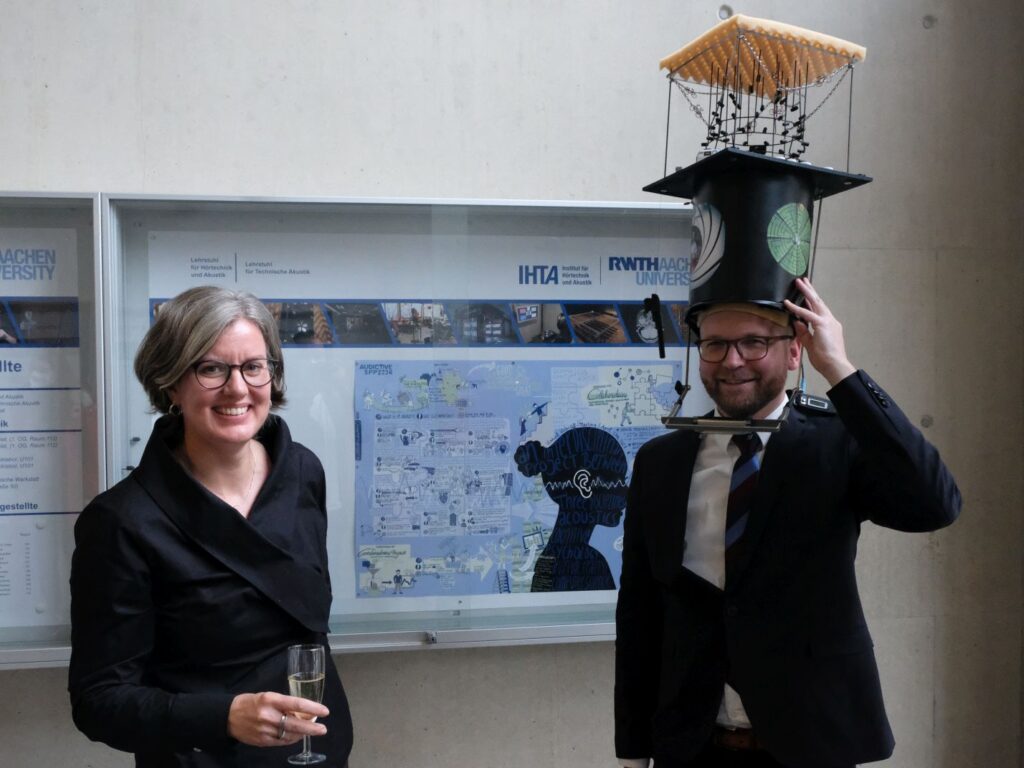
Doktorprüfung Florian Pausch. Prof. Dr.-Ing. Janina Fels und Dipl.-Ing. Florian Pausch. Foto: Mark Müller-Giebeler
Das IHTA gratuliert sehr herzlich!!
Young Professionals Grant at inter-noise 2021
From August 1st, 2021 until August 5th, 2021, the 50th International Congress and Exposition on Noise Control Engineering (inter-noise 2021) was held in online mode (originally it was planned to take place in Washington, DC).

Our PhD student Christian Dreier participated in this event and presented the paper Sound source modelling by nonnegative matrix factorisation for virtual reality applications. Related to this contribution, he was selected as a winner of the Young Professionals Grant Competition by the Institute of Noise Control Engineering (I-INCE) – congratulations to Christian for this award!
- Remote sensing of aircraft noise
- Source separation
- Certificate of the award





